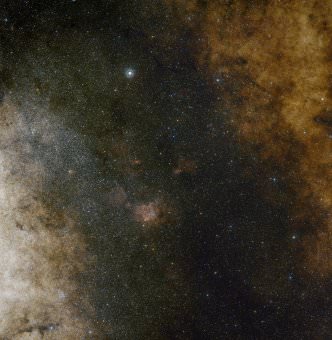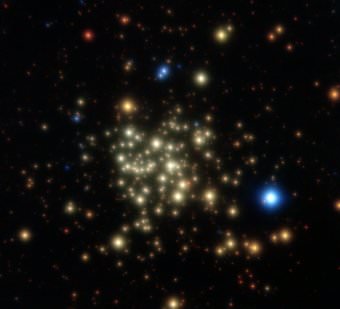[/caption]
Stars don’t seem to mind where they grow up. Either in a nice quiet neighborhood or in the hellish environment near a supermassive black hole, astronomers were surprised to find the same proportions of low- and high-mass young stars in different types of star forming regions. Using the Very Large Telescope, astronomers snapped one of the sharpest views ever of the Arches Cluster — an extraordinary dense cluster of young stars near the supermassive black hole at the center of the Milky Way. “With the extreme conditions in the Arches Cluster, one might indeed imagine that stars won’t form in the same way as in our quiet solar neighbourhood,” says Pablo Espinoza, the lead author of the paper reporting the new results. “However, our new observations showed that the masses of stars in this cluster actually do follow the same universal law”.
The massive Arches Cluster is located 25 000 light-years away towards the constellation of Sagittarius. It contains about a thousand young, massive stars, less than 2.5 million years old. Astronomers say this region is an ideal laboratory to study how massive stars are born in extreme conditions, as the stars in the cluster experience huge opposing forces from all the activity going on near the supermassive black hole. The Arches Cluster is also ten times heavier than typical young star clusters scattered throughout our Milky Way and is enriched with chemical elements heavier than helium.

Using the NACO adaptive optics on the VLT, astronomers were able to take the clearest images yet of the Arches Cluster. Observing the Arches Cluster is very challenging because of the huge quantities of light-absorbing dust between Earth and the Galactic Centre, which visible light cannot penetrate. This is why NACO was used to observe the region in near-infrared light.
The new study confirms the Arches Cluster to be the densest cluster of massive young stars known. It is about three light-years across with more than a thousand stars packed into each cubic light-year — an extreme density a million times greater than in the Sun’s neighborhood.
Astronomers studying clusters of stars have found that higher mass stars are rarer than their less massive brethren, and their relative numbers are the same everywhere, following a universal law.
The astronomers were also able to study the brightest stars in the cluster. “The most massive star we found has a mass of about 120 times that of the Sun,” says co-author Fernando Selman. “We conclude from this that if stars more massive than 130 solar masses exist, they must live for less than 2.5 million years and end their lives without exploding as supernovae, as massive stars usually do.”
The total mass of the cluster seems to be about 30,000 times that of the Sun, much more than was previously thought. “That we can see so much more is due to the exquisite NACO images,” says co-author Jorge Melnick.
Read the team’s paper.
Source: ESO


If that’s correct…. wow!
It’s about 0.005 to 0.01 stars per cubic light-year in our part of the Galaxy (I’m guessing), is that right?
A star every 6000 AU, or thereabouts??
What would the sky look like – would I be wearing shades at night???
Geeez,some stars mass 120x that of Sun and hundreds of massive stars within a few thousand AU from each other!!! Any advanced lifeform on a planet would have to have a more robust body of a large cockroach to survive more than a few months in that nasty environment, and that’s assuming that ‘advanced lifeform cockroach’ came from elsewhere to visit ’cause I doubt life can start ti get a foothold in that environment-the skies would be impressive, but deadly!!!!!
I don´t know why but my mind had me visualizing six or seven variable sized arches of stars around what seems to be a common center. I bet if motion could be accelerated we´d be looking at rotating collar beads of stars in orthogonal planes…Have these star motions been actually determined?
I must say I’m not terribly surprised about the ease with which planets and now stars form in various environments. … after observing the various conditions that allow dust-bunnies to procreate. 😮
I was wondering about this, yesterday, while reading the article at ESO’s website: How do stars upward of 130 solar masses die, anyway?
I had assumed that the really massive ones — starting from 8-10 solar masses or so — all go off in a supernova.
I’d appreciate if someone would answer my question.
Navneeth Says
Your pointing to the issue of stars >130 solar mass got me to thinking. I would’ve though a protostar of say 200 solar mass can’t really be a spherical object and can’t be really called a star as the object would tear itself apart relatively quick. In other words, any object >130 solar mass really does not die as my thinking is they really did not fully form. However, I am not an expert nor have any degree in the field on this subject, and I hope an expert in the field can answer your question.
I question this observation and the assumptions made in this report!
This is an two dimentional picture and maybe false. This picture was edited for reasons unkown to me?
Bravehart Says
What gain would this post have if they falsify the report? There are denser, higher mass star clusters found in other galaxies.
Navneenth, I think such high mass stars (150-200+ solar mass) will proceed to collapse into a supergiant or Wolf-Rayet star. At the same time, this newly forming massive star will desperately try to shed as much mass as possible to try to achieve hydrostatic equilibrium (q.v. Eta Carinae). If this mass-loss period continues long enough with few interruptions, possibly some stars in the Arches Cluster may escape going supernova at the end of their lives and end up as White Dwarfs or accreting compact sources.
An interesting overview paper was published last year (2008) by Don Figer entitled “Massive Star Formation in the Galactic Center”. A copy of this short, informative paper can be found here: http://www.cis.rit.edu/~dffpci/private/papers/stsci06/stsci06.pdf . Dr Figer specifically concentrates on the latest research on the Central Cluster of our Milky Way, the Arches Cluster and the Quintuplet Cluster (and its’ ‘Pistol Star’). MANY references are provided for all three massive clusters up to the date of publication (March 2008). Also included are useful diagrams highlighting these clusters and their positions and proximity to the center of our galaxy. And, of course, many painstakingly acquired images of these objects are also included. Interested readers would do well to check out the paper, as it reflects current research on these home grown massive stellar clusters and the bizarre neighborhood they inhabit 🙂
Btw: Dr Flimmer, the above paper I reference concludes that hot, ionizing radiation from the Arches Cluster and the Quintuplet Cluster are responsible in part for the chaotic appearance of the radio emission from the center of our galaxy, contrary to the ‘plasmoid’ conjecture proffered in previous posts here at UT 🙂
@ Jon Hanford:
🙂 😀 Thanks for the information!
But when I read the newsletter from ESO about this cluster, today, I was also really astonished. The numbers are incredible! Unimaginable what nature is doing!
I guess that our good “friends of the plasmoid” would doubt those numbers (density, mass, etc) – just because the numbers are so tremendous.
@ Dr Flimmer: I heartily agree that a closeup look with human eyes at these monstrous stellar clusters would be mind-boggling (properly shielded, of course 🙂 ) ! And what a bizarre neighborhood they must inhabit.
Imagine a planet far enough away that it can inhabit forms of life that is not burned away directly ( 😉 ), but close enough that the “forms” are able to see the cluster in all its beauty. I guess, day and night are practically the other way around, because the cluster could be much brighter than the single star where the planet belongs to. 6000 stars close by and probably as bright as Sirius in average – Gee, what a view….
This becomes even weirder if one considers that we can only see about 6000 stars at all assuming a clear sky (I think I have never seen so many stars, damn light-pollution). And now compare it to 6000 stars close by in a giant cluster…. Amazing!
DrFlimmer, a preprint paper was posted Tuesday, June 16, 2009 on the arXiv here: http://arxiv.org/PS_cache/arxiv/pdf/0906/0906.2637v1.pdf detailing H.E.S.S. observations of massive nuclear star clusters near the center of our galaxy (including Westerlund 1 & 2). The total power output of these clusters is truly stupendous!